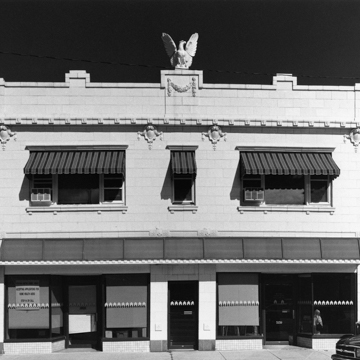Terra-cotta became a popular building material in the United States after the Great Chicago Fire of 1871. Hollow terra-cotta blocks made by the Chicago Terra-Cotta Company were fireproof, lightweight, and inexpensive, and they could be molded with lavish ornamentation and glazed in a palette of rich colors. Although often associated with skyscrapers, terra-cotta could add a sleek, stylish touch, without excessive expense, to smaller buildings.
Kenosha’s 6th Avenue boasts three attractive terra-cotta-clad commercial buildings. The Graham Block (5036–5038 6th Avenue) began as a plain brick building, probably around 1915. But in 1927, new owners Ida and Gustave Graham opened a café in the 5038 storefront and covered its facade with terra-cotta tiles. Framing the storefront, the tiles form recessed-panel pilasters with foliated capitals. On the second story, subtle torch motifs divide the windows. Far more ornate is the two-story Ansorge Fish Market at number 5159, built around 1922 when Kenosha was developing a thriving commercial fishing industry. A glazed-tile veneer bedecked with festive ornamentation transforms this otherwise simple three-bay brick building into an inviting market. Among the delightful details are floral medallions, floral and geometric capitals, and scroll and swag cartouches. A large ceramic eagle perches atop the crenellated parapet.
The luxuriously decorated terra-cotta-sheathed Kenosha Theater (1927; 5915 6th) was affiliated with Hollywood’s Universal Studio. It was the first theater in town to screen talking pictures and also showcased live entertainment. A still visible sign on the building’s north side touts these attractions. Like many contemporary cinemas, the three-story building adopted an exotic architectural theme, in this case Moorish. Red brick minarets flank a curvilinear parapet sheathed in diamond-shaped tiles. Pilasters decorated with foliated motifs separate three columns of windows, where even more elaborate decoration includes leaf motifs on the spandrels between windows and theatrical masks overhead.









